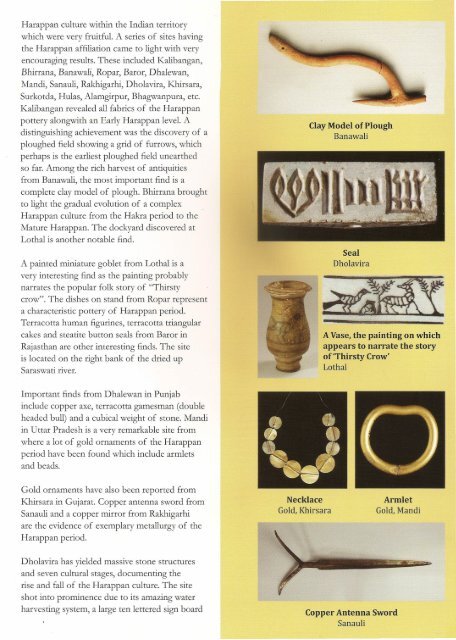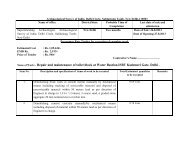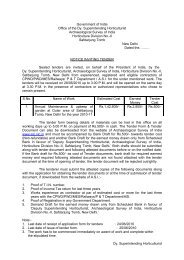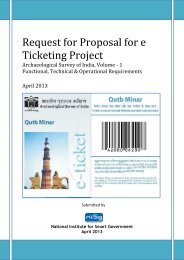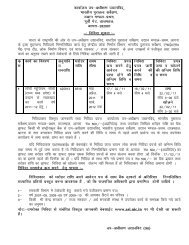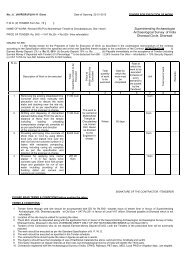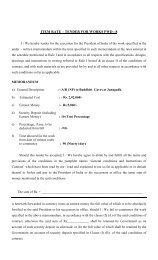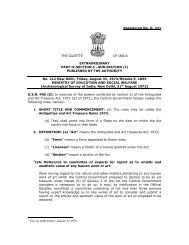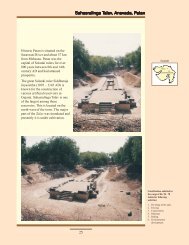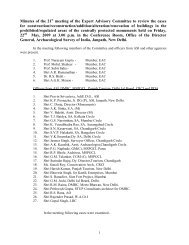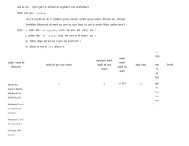Rediscovering India Exhibition - Archaeological Survey of India
Rediscovering India Exhibition - Archaeological Survey of India
Rediscovering India Exhibition - Archaeological Survey of India
You also want an ePaper? Increase the reach of your titles
YUMPU automatically turns print PDFs into web optimized ePapers that Google loves.
Harappan culture within the <strong>India</strong>n territory<br />
which were very fruitful. A series <strong>of</strong> sites having<br />
the Harappan affiliation came to light with very<br />
encouraging results. These included Kalibangan,<br />
Bhirrana, Banawali, Ropar, Baror, Dhalewan,<br />
Mandi, Sanauli, Rakhigarhi, Dholavira, Khirsara,<br />
Surkotda, Hulas, Alamgirpur, Bhagwanpura, ete.<br />
Kalibangan revealed all fabrics <strong>of</strong> the Harappan<br />
pottery alongwith an Early Harappan level. A<br />
distinguishing achievement was the discovery <strong>of</strong> a<br />
ploughed field showing a grid <strong>of</strong> furrows, which<br />
perhaps is the earliest ploughed field unearthed<br />
so far. Among the rich harvest <strong>of</strong> antiquities<br />
from Banawali, the most important find is a<br />
complete clay model <strong>of</strong> plough. Bhirrana brought<br />
to light the gradual evolution <strong>of</strong> a complex<br />
Harappan culture from the Hakra period to the<br />
Mature Harappan. The dockyard discovered at<br />
Lothal is another notable find.<br />
A painted miniature goblet from Lothal is a<br />
very interesting find as the painting probably<br />
narrates the popular folk story <strong>of</strong> "Thirsty<br />
crow". The dishes on stand from Ropar represent<br />
a characteristic pottery <strong>of</strong> Harappan period.<br />
Terracotta human figurines, terracotta triangular<br />
cakes and steatite button seals from Baror in<br />
Rajasthan are other interesting finds. The site<br />
is located on the right bank <strong>of</strong> the dried up<br />
Saraswati river.<br />
Important finds from Dhalewan in Punjab<br />
include copper axe, terracotta gamesman (double<br />
headed bull) and a cubical weight <strong>of</strong> stone. Mandi<br />
in Uttar Pradesh is a very remarkable site from<br />
where a lot <strong>of</strong> gold ornaments <strong>of</strong> the Harappan<br />
period have been found which include armlets<br />
and beads.<br />
Gold ornaments have also been reported from<br />
Khirsara in Gujarat. Copper antenna sword from<br />
Sanauli and a copper mirror from Rakhigarhi<br />
are the evidence <strong>of</strong> exemplary metallurgy <strong>of</strong> the<br />
Harappan period.<br />
Dholavira has yielded massive stone structures<br />
and seven cultural stages, documenting the<br />
rise and fall <strong>of</strong> the Harappan culture. The site<br />
shot into prominence due to its amazing water<br />
harvesting system, a large ten lettered sign board<br />
Necklace<br />
Gold, Khirsara<br />
Clay Model <strong>of</strong> Plough<br />
Banawali<br />
Seal<br />
Dholavira<br />
A Vase, the painting on which<br />
appears to narrate the story<br />
<strong>of</strong> 'Thirsty Crow'<br />
Lothal<br />
Copper Antenna Sword<br />
Sanauli<br />
Armlet<br />
Gold, Mandi


